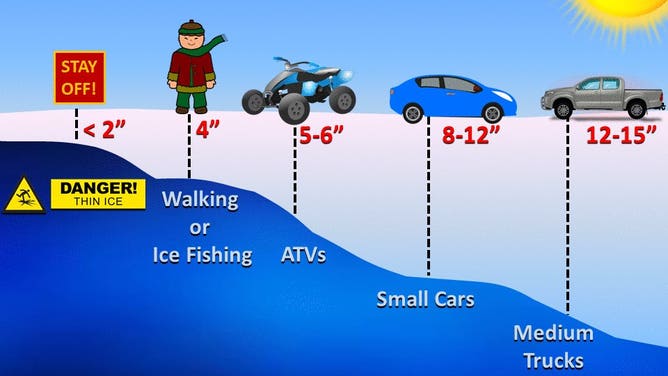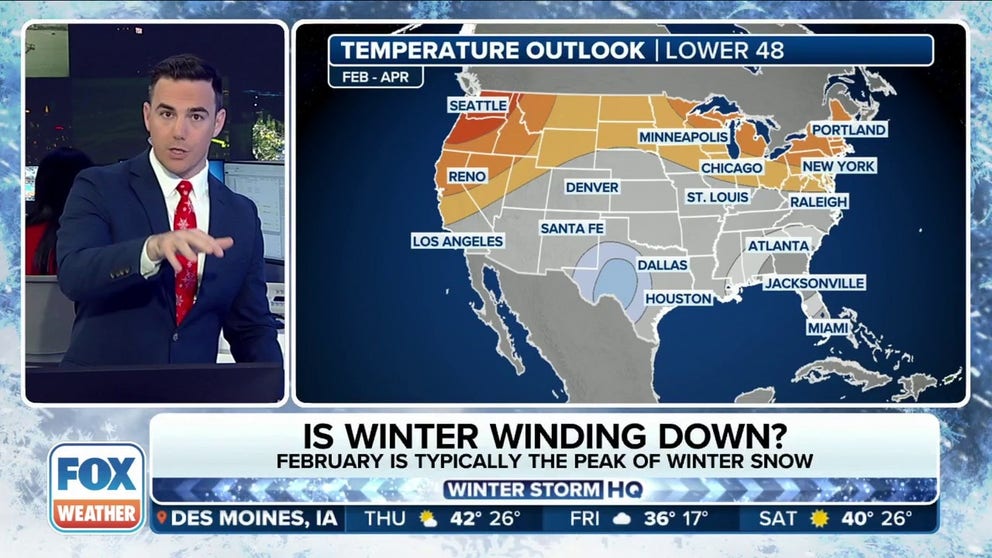Warm winter leads to continued record-low ice along Great Lakes
Great Lakes ice coverage was measured at 2.7% on Feb. 11, 2024. Both Lakes Erie and Ontario were essentially ice-free. Ice coverage tends to peak between mid-February and March as temperatures start to rebound into the spring.
Winter is winding down across the US
Above average temperatures are expected to continue through the last month of meteorological winter and into spring across a large swath of the country.
A historically warm winter across the northern tier of the country has led to ice production along lakes and ponds that can best be described as anemic.
As of mid-February, NOAA reported that Great Lakes ice coverage clocked in at around 2.7%, which was a historic low.
Both Lakes Erie and Ontario were essentially ice-free when they should be nearing the peak of coverage for the year.
"We’ve crossed a threshold in which we are at a historic low for ice cover for the Great Lakes as a whole," Bryan Mroczka, a physical scientist at NOAA’s Great Lakes Environmental Research Laboratory, said in a statement. "We have never seen ice levels this low in mid-February on the lakes since our records began in 1973."

(FOX Weather)
THIN ICE: LAKES BEAR IMPACTS FROM WARM WINTER
The winter season (2023-24) began with historically warm air temperatures in December, followed by only a brief period of cold in January.
The few weeks of winter-like temperatures caused ice across the five Great Lakes to peak at between 15-20% of coverage, well below the 53% mark that is usually reached in late February and early March.
Another warm spell in February all but halted ice production and caused significant melting along the lakes, leading to the current record lows.
The unfrozen lakes allowed storm systems to take advantage of the available moisture in the form of lake-effect snow.
Several communities downwind of Lakes Michigan, Erie and Ontario reported seeing snowfall events with accumulations in feet, not inches.
Fortunately, the El Niño storm track was not in a position to deliver historic accumulations despite the lakes being open for business for Mother Nature.
As of mid-February, Buffalo, New York, reported a snowfall deficit of more than 16" and Erie, Pennsylvania, was in the red by more than 56".

(FOX Weather)
Aside from human impacts, NOAA warns that it’ll be monitoring for effects on the fish population. The agency said some marine animals rely on ice for protection from predators, and without the natural barrier, there are bound to be some ecosystem changes.
7 WAYS TO STAY SAFE ON ICE, AND WHAT TO DO IF YOU FALL THROUGH
Warm weather results in problematic ice
Problems associated with thin ice have plagued lakes from Alaska through Maine, with hundreds of rescues and several fatalities.
Abnormally warm temperatures in December, January and February prevented thick layers of ice from forming on lakes, causing the ice to be thinner than what is typical.
At least 4 inches of ice is needed to support a human’s weight sufficiently, and at least eight inches is recommended before attempting to drive a small-sized vehicle on it.

If ice is below 4" in depth it is advised you stay off.
(National Weather Service / FOX Weather)
Ice coverage tends to peak between mid-February and March, but the continuation of one of the warmest winters on record means many communities might have already experienced their most extensive ice coverage of the season.
NOAA says the lack of ice can make the shoreline more susceptible to erosion and large waves during storm systems.
